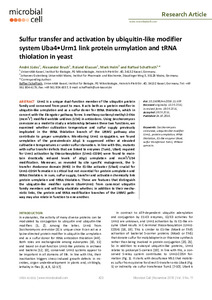| dc.date.accessioned | 2016-11-09T10:48:30Z | |
| dc.date.available | 2016-11-09T10:48:30Z | |
| dc.date.issued | 2016-10-24 | |
| dc.identifier.issn | 2311-2638 | |
| dc.identifier.uri | urn:nbn:de:hebis:34-2016110951326 | |
| dc.identifier.uri | http://hdl.handle.net/123456789/2016110951326 | |
| dc.description.sponsorship | Gefördert durch den Publikationsfonds der Universität Kassel | |
| dc.language.iso | eng | |
| dc.rights | Urheberrechtlich geschützt | |
| dc.rights.uri | https://rightsstatements.org/page/InC/1.0/ | |
| dc.subject | Saccharomyces cerevisiae | eng |
| dc.subject | ubiquitin-like modifier Urm1 | eng |
| dc.subject | protein urmylation | eng |
| dc.subject | tRNA thiolation | eng |
| dc.subject | E1-like enzyme Uba4 | eng |
| dc.subject | sulfur transferase Tum1 | eng |
| dc.subject | tRNase zymocin | eng |
| dc.subject.ddc | 570 | |
| dc.title | Sulfur transfer and activation by ubiquitin-like modifier system Uba4•Urm1 link protein urmylation and tRNA thiolation in yeast | eng |
| dc.type | Aufsatz | |
| dcterms.abstract | Urm1 is a unique dual-function member of the ubiquitin protein family and conserved from yeast to man. It acts both as a protein modifier in ubiquitin-like urmylation and as a sulfur donor for tRNA thiolation, which in concert with the Elongator pathway forms 5-methoxy-carbonyl-methyl-2-thio (mcm5s2) modified wobble uridines (U34) in anticodons. Using Saccharomyces cerevisiae as a model to study a relationship between these two functions, we examined whether cultivation temperature and sulfur supply previously implicated in the tRNA thiolation branch of the URM1 pathway also contribute to proper urmylation. Monitoring Urm1 conjugation, we found urmylation of the peroxiredoxin Ahp1 is suppressed either at elevated cultivation temperatures or under sulfur starvation. In line with this, mutants with sulfur transfer defects that are linked to enzymes (Tum1, Uba4) required for Urm1 activation by thiocarboxylation (Urm1-COSH) were found to maintain drastically reduced levels of Ahp1 urmylation and mcm5s2U34 modification. Moreover, as revealed by site specific mutagenesis, the Stransfer rhodanese domain (RHD) in the E1-like activator (Uba4) crucial for Urm1-COSH formation is critical but not essential for protein urmylation and tRNA thiolation. In sum, sulfur supply, transfer and activation chemically link protein urmylation and tRNA thiolation. These are features that distinguish the ubiquitin-like modifier system Uba4•Urm1 from canonical ubiquitin family members and will help elucidate whether, in addition to their mechanistic links, the protein and tRNA modification branches of the URM1 pathway may also relate in function to one another. | eng |
| dcterms.accessRights | open access | |
| dcterms.bibliographicCitation | In: Microbial cell. - Graz : Shared Science Publ., 2016, Vol. 3, 11, 423-433 | |
| dcterms.creator | Jüdes, André | |
| dcterms.creator | Bruch, Alexander | |
| dcterms.creator | Klassen, Roland | |
| dcterms.creator | Helm, Mark | |
| dcterms.creator | Schaffrath, Raffael | |
| dc.relation.doi | doi:10.15698/mic2016.11.539 | |

